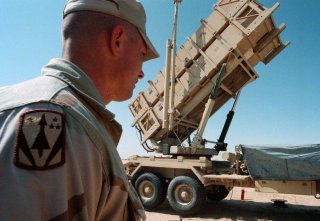Why the U.S. Army Is Undertaking Rocket Recycling (Think Missile Tests)
The Army reportedly saves roughly 50 percent of what it could cost to replace targets over buying new ones and it saves time, too.
There have been calls for increased efforts to “recycle” over the years, but this hasn’t always been possible when it comes to military hardware. However, the U.S. Army is now recycling and reutilizing demilitarized rocket motors and even repurposing the materials to make test missiles.
In May 2018 the Army opened the Anniston Munitions Center’s Launch Rocket System Recycle (MLRS) facility at the Anniston Army Depot in Alabama. The facility enabled the Army to demilitarize the MLRS warheads, recycle the metal parts and reduce the aging munitions at a lower cost than previous options.
The project was ten years in the making but came about via a partnership with Product Support Director for Demilitarization, The U.S. Army Aviation and Missile Command Missile Demilitarization Office, the U.S. Army Aviation and Missile Research and Development and Engineering Center and several contracting firms. The facility was designed, built and tested to implement a safe capability for the closed system of demilitarization of M26 MLRS warheads and M77 sub-munitions.
Zombie Rockets
The efforts have advanced, and this week Defense News reported that the Army’s efforts now include the creation of “zombies,” which are test missiles that save the Army from having to destroy old boosters and instead gives them new life. It might not be entirely green in terms of the materials being recycled, but instead these are being repurposed for use as targets for Patriot testing.
In addition, the boosters have been used by the Missile Defense Agency and for foreign military sales test events. A zombie booster was the target used in a critical test that highlighted how the Patriot platform could be interoperable with the Army’s Terminal High Altitude Area Defense (THAAD) System. The Army acquired around two hundred THAAD rockets for its seven batteries and roughly forty launchers last year.
The Patriot Advanced Capability-3 Missile Segment Enhancement (PAC-3 MSE) has seen production double to meet the needs for the U.S. Army and its allies and that means more testing will be required.
This testing effort started several years ago when the Army’s Program Executive Office for Missiles and Space, as well as Patriot air and missile defense lower-tier product office, was running out of targets for tests and spending more money to buy the additional targets.
The Army reportedly saves roughly 50 percent of what it could cost to replace targets over buying new ones and it saves time, too. The old boosters make a more affordable but also far more effective target that can be used in weapon testing. The Army has built seven targets to date, and Defense News indicated that these included three variants: Pathfinder Zombie; the Black Dagger Zombie that adds an additional booster—the Terrier MK70—for longer ranges; and Sabre, a shorter-range version.
The targets will also be reported used in some of the upcoming tests to help Department of Defense (DoD) officials make decisions on the Lower-Tier Air-Defense Sensor (LTAMDS), the future radar for the U.S. Army’s Integrated Air-and-Missile Defense System to replace the Patriot. Unlike the more linear directional configuration of the existing Patriot air and missile defense system, the Raytheon-built LTAMDS is engineered with overlapping 120-degree arrays intended to seamlessly track approaching threats using a 360-degree protection envelope.
Peter Suciu is a Michigan-based writer who has contributed to more than four dozen magazines, newspapers and websites. He is the author of several books on military headgear including A Gallery of Military Headdress, which is available on Amazon.com.
Image: Reuters

